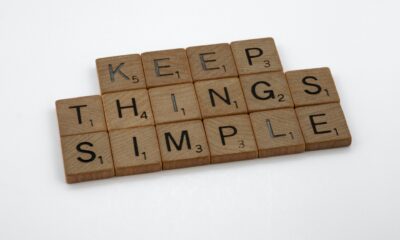Lifestyle
Retirement Hobbies: Exploring Your Passions

Retirement is a time of liberation, a period in life when you finally have the freedom to pursue your passions. It’s a golden opportunity to engage in activities that not only stimulate your mind and body but also bring joy and fulfillment.
Exercise
Let’s start with the physical aspect. Exercise is vital for maintaining good health, especially as we age. But who said it has to be a chore? Why not turn it into a hobby? Think about activities you’ve always wanted to try. Perhaps it’s golf, swimming, or even ballroom dancing. These activities are not only fun but also provide excellent cardio workouts.
On the other hand, yoga and Tai Chi are excellent choices for enhancing flexibility and balance, two aspects that tend to decline as we age. These ancient practices also foster mental wellness by reducing stress and promoting a sense of inner peace.
Speaking of mental wellness, hobbies that challenge the mind are just as important as those that exercise the body. Retirement is the perfect time to learn a new language or musical instrument, both of which have been shown to improve cognitive function.
Arts
If you’re more artistically inclined, consider painting, pottery, or photography. These creative outlets provide a sense of accomplishment and can be incredibly therapeutic. Plus, you never know – you might just discover a hidden talent!
Nutrition is another key aspect of health and longevity, and cooking is a fantastic way to ensure you’re eating well. Exploring new recipes and cooking techniques can be a delightful hobby. It’s a chance to play with flavors, experiment with different cuisines, and create nutritious meals that fuel your body and satisfy your palate.
Gardening
Gardening is another hobby that combines physical activity with the joy of nurturing life. It’s a wonderful way to spend time outdoors and can even provide fresh, organic produce for your kitchen.
Volunteering
One of the most rewarding aspects of retirement is the opportunity to give back. Volunteering is a hobby that benefits both the giver and the receiver. Whether it’s mentoring a young person, helping out at a local food bank, or caring for animals at a shelter, there’s a volunteer opportunity to suit every passion.
Reading
Finally, let’s not forget the simple joy of reading. Whether you prefer novels, biographies, or non-fiction, reading is a hobby that can transport you to different worlds, broaden your horizons, and keep your mind sharp.
Remember, retirement is not an end, but a new beginning. It’s a time to explore your passions, learn new skills, and engage in activities that bring you joy. So, go ahead and embrace this exciting phase of life. After all, you’ve earned it.

Lifestyle
Unlocking Weight Loss: The Truth Behind the ‘Calories In, Calories Out’ Approach

For years, the notion that weight loss boils down to a simple equation—consume fewer calories than you expend—has been widely accepted. This concept underpins the CICO diet, which stands for “calories in, calories out.” However, the intricacies of weight management extend far beyond mere calorie counting.
The CICO approach is not tied to any specific book or celebrity endorsement. It operates on the straightforward logic that weight loss occurs when you consume fewer calories than you burn, while weight gain happens when the opposite is true. To achieve weight loss, followers of the CICO diet aim to maintain a calorie deficit. For instance, if your daily intake is 3,500 calories, reducing it by 500 calories per day could theoretically lead to losing a pound per week. Alternatively, incorporating exercise to burn additional calories can also help maintain this deficit.
Despite its apparent simplicity, the CICO model doesn’t consider various factors influencing weight management, such as genetics, hormonal balance, diet quality, medications, and stress levels. These elements can significantly impact individual weight loss experiences, making it challenging to predict weight changes solely based on calorie calculations.
While the theory suggests you can eat anything within your calorie limit and still lose weight, real-life application is more complex. People often use calorie counter apps to stay on track with the CICO diet, but managing weight through calorie restriction isn’t straightforward.
Calories indeed matter in weight management, but not all calories are equal. Calories are the energy derived from food, whether it’s an orange, orange juice, or orange soda. However, the processing of food can affect weight management outcomes.
A study compared diets based on processed foods with those based on whole foods, both offering equivalent calories and nutrients. Participants on the processed food diet consumed about 500 more calories and gained approximately two pounds over two weeks. This discrepancy might be due to faster eating and delayed satiety signals associated with processed foods. For example, a chewy granola bar may be consumed more quickly than a bowl of oatmeal, which feels more filling.
In the United States, a significant portion of calorie intake comes from ultraprocessed foods, such as sodas and packaged snacks. Studies indicate that these foods may contribute to unintentional weight gain and adverse health effects like elevated blood pressure and cholesterol levels.
Critics of the CICO model argue that it assumes uniform calorie absorption, which isn’t accurate. The body processes calories from whole foods differently. Research shows that adults consuming more whole grains tend to have lower body weights, possibly because calories from whole grains are not absorbed as efficiently as those from refined grains. Similarly, studies on almonds suggest that fewer calories are absorbed from nuts than expected, contributing to healthier body measurements.
Certain foods offer more satiety per calorie. The satiety index ranks foods based on how filling they are per calorie. For instance, boiled potatoes are seven times more filling than croissants. Similarly, fish is more filling than beef or eggs, and oatmeal surpasses bran cereal in satiety.
Focusing on calorie needs and understanding how different foods affect satiety can be more effective than solely counting calories. Managing appetite with filling foods that align with caloric needs aids in weight management and hunger control.
Liquid calories pose a unique challenge, as the body doesn’t register them as effectively as calories from solid foods. Beverages like sodas and sweetened coffee drinks may not satisfy hunger, leading to a calorie surplus. This is because stomach nerves assess fullness based on stomach stretch, which is less pronounced with liquids.
The CICO diet’s simplicity is both an advantage and a disadvantage. It allows flexibility, permitting any eating pattern, such as gluten-free or low FODMAP diets, while adhering to calorie guidelines. Monitoring weight can enhance weight loss success, and tracking dietary intake can highlight areas for improvement, such as fiber or vegetable consumption.
However, the CICO diet’s lack of emphasis on whole foods may overlook the benefits of nutrient-dense foods that promote health and satiety. Moreover, the focus on calorie tracking can induce stress and potentially lead to disordered eating.
The CICO diet doesn’t address emotional eating or the reasons behind food choices, such as stress-induced snacking or cravings after poor sleep. It also doesn’t teach mindful eating techniques, which can prevent overeating and aid in weight management.
While the CICO diet offers a straightforward approach to weight management, it may not account for the complexities of individual health and nutrition. Balancing calorie awareness with an understanding of food quality and eating habits may lead to more sustainable and healthful weight management.
Let us know what you think, please share your thoughts in the comments below.
Lifestyle
Discover the Varieties of Tinnitus: A Guide to Understanding Different Types

Tinnitus is a condition that manifests as a ringing or buzzing in the ears without an external sound source. It is prevalent among adults, affecting between 10% and 25% of the population, though children can also experience it. The condition can be temporary or develop into a chronic issue, depending on its type and severity.
When diagnosed with tinnitus, it is typically categorized into one of three types: subjective, objective, or somatic. Each type has distinct causes and treatment options. Understanding these differences is crucial for effective management.
Subjective tinnitus is the most common form, characterized by sounds that only the affected individual can hear. A leading cause of subjective tinnitus is noise trauma, particularly for those working in loud environments like construction sites or concert venues. Other underlying medical conditions can also contribute to this form of tinnitus.
In terms of treatment, addressing any underlying health issues is the first step. Cognitive behavioral therapy (CBT) is often recommended to help manage the condition. Additionally, techniques such as noise masking and stress reduction can be beneficial. For those with concurrent hearing loss, hearing aids may provide relief.
Despite the lack of a specific medication to treat tinnitus directly, doctors may prescribe anti-anxiety medications or antidepressants. These can help manage the mental health side effects and improve sleep quality. “Overall, CBT has been shown to improve quality of life more than any other treatment method used for tinnitus.”
Understanding the type of tinnitus one has is essential for tailoring the most effective treatment plan. Each form of tinnitus has unique characteristics and requires a specialized approach to manage symptoms and improve quality of life.
Let us know what you think, please share your thoughts in the comments below.
Lifestyle
Unlock Your Best Self: Discover the Perfect Sleep Hours for Optimal Health

Understanding how much sleep you need is crucial for maintaining optimal health and well-being. Just like a balanced diet and regular exercise, sufficient sleep is a cornerstone of a healthy lifestyle. Yet, when life gets hectic, sleep is often the first thing we compromise.
For most adults, the sweet spot is between 7 to 9 hours of sleep per night. However, this range can fluctuate based on several personal factors. It’s important to recognize that everyone has unique sleep needs, influenced by various elements such as age and genetics.
Age is a primary determinant of how much sleep you require. Sleep duration recommendations are typically segmented by age groups. While these guidelines provide a general framework, individual differences mean some people might need more or less sleep than the average.
Genetics also play a significant role in determining your sleep needs. Some genetic mutations can influence not only the amount of sleep you require but also your preferred sleep schedule and how you cope with sleep deprivation. For instance, a specific genetic mutation allows some individuals to function well on just 6 hours of sleep, while others without this mutation may need around 8 hours.
“Your genetic makeup isn’t something you can change, and there’s no practical way to know whether you carry one of these mutations.”
Thus, it’s crucial to listen to your body and assess how you feel to gauge if you’re getting enough rest.
The quality of your sleep significantly impacts how much rest you need. Poor sleep quality can leave you feeling exhausted even after a full night’s sleep. On the other hand, high-quality sleep might allow you to function well with slightly less sleep.
“Short sleep duration and low sleep quality are responsible for many adverse sleep-related effects.”
For example, studies have shown that poor sleep quality is linked to increased stress levels. Therefore, focusing on both the quantity and quality of sleep is essential.
Sleep disorders, such as sleep apnea, can also detrimentally affect sleep quality. If you frequently wake up feeling unrested or experience unexplained fatigue, consulting a healthcare professional is advisable.
The amount of sleep you require is influenced by a variety of factors, including your age, genetic predispositions, and the quality of your sleep. While 7 to 9 hours per night is generally recommended for adults, paying attention to how you feel can help you determine your personal sleep needs.
Let us know what you think, please share your thoughts in the comments below.
-

 Health6 months ago
Health6 months ago17-Second Neuropathy Solution
-

 Nutrition10 months ago
Nutrition10 months agoThe Aging Secret of Vitamin D Unveiled
-

 Health1 year ago
Health1 year agoPreventing Falls and Injuries for Seniors
-

 Health5 months ago
Health5 months agoOncologist Reveals Top 5 Cancer Prevention Tips You Shouldn’t Ignore
-

 Nutrition1 year ago
Nutrition1 year ago5 AMAZING Dinner Recipes That Are Also HEALTHY
-

 Lifestyle6 months ago
Lifestyle6 months agoSleep Soundly with These 11 Expert-Approved Bedtime Routines
-

 Health11 months ago
Health11 months agoDownsizing Tips: Simplifying Your Lifestyle
-

 Lifestyle2 months ago
Lifestyle2 months agoMorning Habits That Could Add Years to Your Life
Barbara Dunham
January 20, 2024 at 5:30 pm
Reading – my favorite.